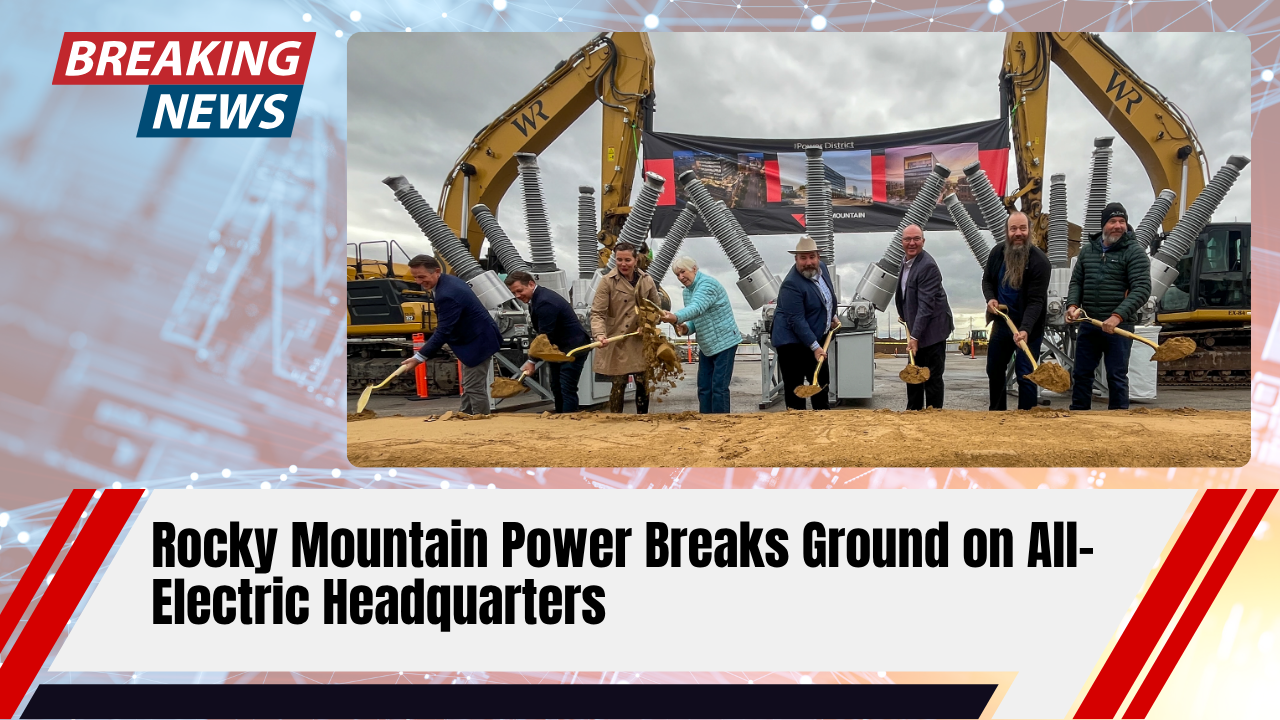SALT LAKE CITY — Utah and Salt Lake City leaders officially broke ground Monday on Rocky Mountain Power’s new 10-story, all-electric headquarters, marking the first major project within the city’s ambitious Power District redevelopment — a massive plan set to reshape the city’s west side.
The new 300,000-square-foot corporate campus will serve as the operations hub for 3,000 Rocky Mountain Power employees, signaling both a technological upgrade and the start of a sweeping revitalization of the utility company’s 100-acre property along North Temple.
“It’s exciting to transition into a new, modern, all-electric headquarters that reflects the innovation we’re bringing to our customers,” said Dick Garlish, president of Rocky Mountain Power, during the groundbreaking ceremony.
The event brought together state lawmakers, Salt Lake City officials, and executives from the Larry H. Miller Company — which acquired much of the surrounding land for redevelopment — despite chilly drizzle and cloudy skies.
A Symbolic First Step in a $10 Billion Vision
For Brad Holmes, president of Larry H. Miller Real Estate, the new headquarters is a symbolic first move in what’s expected to be one of Utah’s largest urban renewal projects.
“The Power District is expanding Salt Lake City’s downtown to the west,” Holmes said. “Rocky Mountain Power is a fitting and foundational starting point for this district.”
The new headquarters, inspired by the historic Gadsby Power Plant, will anchor a larger mixed-use community of offices, residences, restaurants, and entertainment venues. Construction is expected to take two years, with completion and occupancy slated for 2027.
Renderings released by the Larry H. Miller Company show a vibrant urban landscape combining green spaces, mid-rise apartments, and commercial centers — a complete transformation of the industrial corridor west of downtown.
Redevelopment on a Massive Scale
Monday’s groundbreaking follows Salt Lake City’s 2024 approval of a 93-acre rezone for the Miller Company’s land holdings, allowing buildings up to 400 feet tall pending city and FAA review.
The zoning changes pave the way for a mix of residential, commercial, and entertainment developments, including space for a potential Major League Baseball stadium, should Utah secure a team through league expansion.
Under the agreement with the city:
- At least 10% of all future housing will include affordable units.
- 20% of new homes** will offer two or three bedrooms** to meet family housing needs.
- The Miller Company will benefit from expedited city reviews to accelerate construction.
“This is the first visible step in a massive vision that will transform not just the west side of Salt Lake City, but the entire state,” said Mayor Erin Mendenhall. “It’s the first domino in a long chain that will build something phenomenal.”
Connecting to the City’s Growing Core
The Power District will connect with nearby projects like Spark and The Yard, which have already added hundreds of housing units to the area.
Simultaneously, the Utah State Fairpark — located adjacent to the development — is also slated for upgrades, creating a seamless urban corridor of recreation, commerce, and housing.
Investing in the River and the Future
As part of early site work, the Larry H. Miller Company has committed $10 million to infrastructure improvements, site cleanup, and ecological restoration along the Jordan River. The company plans to enhance water quality, native vegetation, and aquatic habitats, while adding new water-based recreation opportunities within the city limits.
“I’m grateful for the river’s thoughtful inclusion in this project and for the remediation work that will soon begin,” Mayor Mendenhall said.
With construction cranes now rising along North Temple, the groundbreaking marks more than the start of a new headquarters — it signals the beginning of a long-term redevelopment effort that city planners say could reshape Salt Lake City’s economic and cultural landscape for decades.



